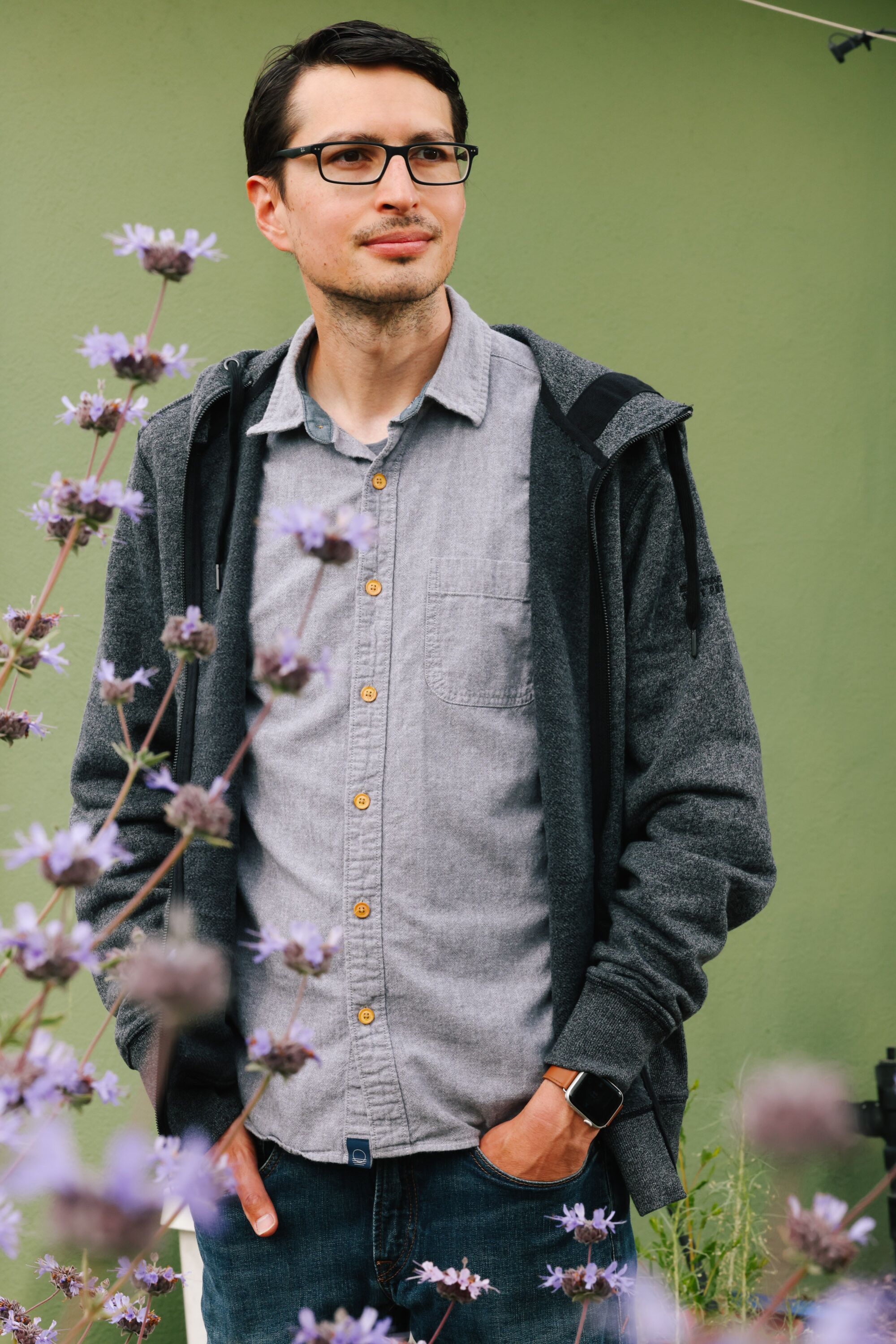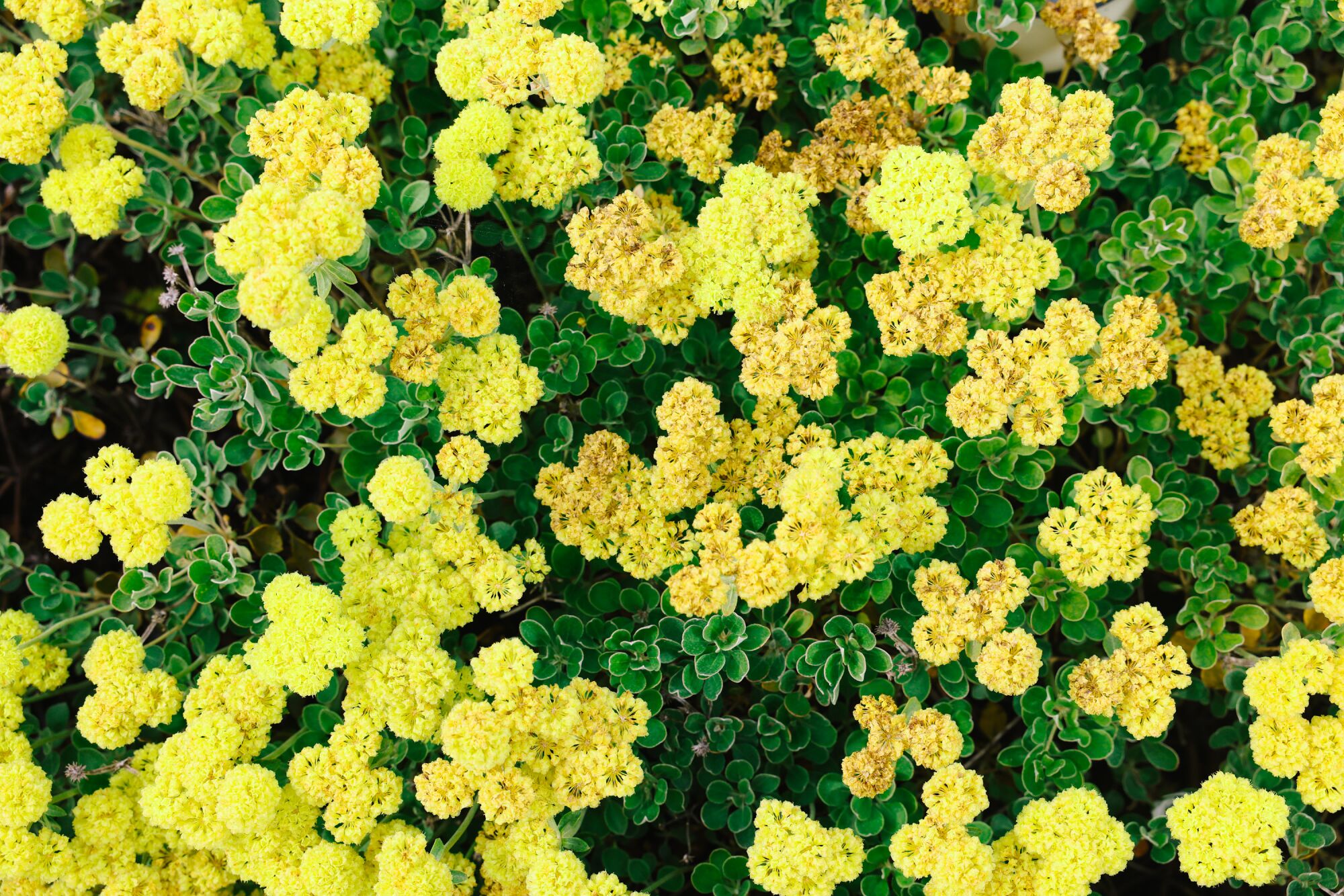
Lawns are symbols of Los Angeles’ past. In this series, we spotlight yards with alternative, low-water landscaping built for the future.
On a closely packed street in Inglewood, where single-family home after single-family home overlooks a manicured lawn, a spectacular garden filled with California native plants reaches to the sky and spills onto the sidewalk.
In Brian Bautista’s yard, upright showy penstemon, aromatic hummingbird sage, hardy toyon trees, and two types of milkweed — dramatic plants requiring little water — attract birds, butterflies and bees and flourish amid the Bermuda grass lawns.
“I tore out both my front and back yards because they provided little value to the house,” Bautista said of the former patchwork of weeds and grass. “I had to mow it; it never looked good. And I had to keep spending money watering it and maintaining it.”

Brian Bautista’s backyard before he removed the turf and bricks.
(Brian Bautista)

Three years later, Bautista walks down a concrete path he installed himself, surrounded by California native plants and a bioswale, left.
(Dania Maxwell / Los Angeles Times)
Soon after Bautista and his wife, Debora Lee, purchased their first home in 2020 and the pandemic closed down the economy, the 38-year-old visual effects editor embarked on a do-it-yourself gardening overhaul despite having no previous gardening experience.
“All of a sudden, I had more spare time than I knew what to do with since I was no longer going into an office in Hollywood for 60 hours a week to work on movies,” he said. “It was time for an upgrade. I decided to do it myself because we had just bought a house and had no money.”
Living in drought-stricken California, the self-described “millennial with climate change anxiety” decided to remove his lawns and plant a drought-tolerant landscape filled with California native plants.
To get a handle on how to proceed, he enrolled in the Department of Water and Power’s free hands-on “Lawn Be Gone” workshop conducted by the district’s contractor, the G3 Green Gardens Group.

Brian Bautista’s front yard in Inglewood before he removed the lawn.
(Brian Bautista)

Today, Brian Bautista’s neighbor Detonte Smith, 10, admires Palmer’s mallow growing in his front yard.
(Dania Maxwell / Los Angeles Times)
In a two-day workshop held over two weekends, Bautista learned about garden design, turf removal, soil-building, rainwater capture, plant selection, planting and irrigation, and dry garden maintenance.
“They showed us how to use a sod cutter; we installed irrigation and dug a swale,” he said of the project site. “Everyone planted something.”
Armed with eight hours of instruction and a litany of Waterwise Community Youtube videos, Bautista removed the backyard first, “in case it didn’t work out,” he said with a laugh.
Working over six months, he removed the hardscape and bricks and ripped out the old metal irrigation pipes, which were leaking. He then proceeded to sheet mulch the lawn using empty cardboard boxes left over from the couple’s move and a truckload of compost and mulch from U.S. Rock Corp. (In sheet mulching, cardboard or newspaper is placed on a close-cropped lawn to block the sun and prevent growth. The cardboard is then topped with compost and mulch; eventually, the “lasagna” layers decompose to create healthy soil without chemicals or pesticides.)
“It’s a magical process,” he said of sheet mulching. “It didn’t take long at all.”

Apricot mallow, left, desert grape vine, right, and arroyo lupine, bottom right, grow on the garage. Palmer’s Indian mallow foliage influenced the home’s paint color.
(Dania Maxwell / Los Angeles Times)
Once the compost and mulch had been laid, Bautista started planting, and the garden began to take shape: Bright lemon-yellow Palmer’s Indian mallow, tall spikes of Pozo Blue sage and De La Mina verbena, pink flowering heuchera (Martha Roderick and Canyon Duet) and three types of dudleya (Giant Chalk dudleya, Green Form, Fingertips).
He also added gutters and underground pipes to move the gutter water to a new swale (a stormwater retention feature is required to receive a turf removal rebate) that now infiltrates rainwater into the groundwater basin and feeds a 30-year-old guava tree.
“A swale is cheap and affordable and can handle much more water than a rain barrel,” Bautista said. During this year’s record rainfall, Bautista was delighted to see that the swale he installed handled the overflow water “like a champ.”
Regarding landscape design and plant selection, Bautista relied on the California Native Plant Society’s Calscape website and the Waterwise Garden Planner for Southern California as guides. Most plants came from Theodore Payne Nursery in Sun Valley and Artemisia Nursery in El Sereno.

Brian Bautista’s side yard before he removed the lawn and relandscaped.
(Brian Bautista)

Brian Bautista stands at the end of his side yard where a mix of woodland and beach strawberry plants grow, bottom left, and a bush anemone, left, with island alumroot seen right.
(Dania Maxwell / Los Angeles Times)

Succulents grow on a trellis in the side yard above a mix of woodland and beach strawberry plants.
(Dania Maxwell / Los Angeles Times)
“I wanted a low-water, colorful, smell-good garden that works for Inglewood, and those two websites helped me tremendously,” Bautista said. “The site will tell you the plants that naturally grow in your neighborhood. You can research sun exposure, plant type and water needs.”
Before he installed the plants, he applied for a turf removal rebate from the city by scanning a sheet of graph paper into his computer and using Photoshop. (The Metropolitan Water District of Southern California’s turf replacement rebates fluctuate and are currently $2 a square foot for a maximum of 5,000 square feet per year, but some water agencies may offer additional incentives.)
When finished, he received a rebate of $3,309 for removing 1,100 square feet of turf. (He spent $10,993 before the rebate.)
Because applicants can only receive one turf removal rebate per fiscal year, Bautista tackled his front yard a year later. Once again, Bautista started by digging up the first inch of Bermuda grass in the front yard by hand and then sheet mulched the lawn.

Brian Bautista, flanked by Pozo Blue sage in his garden.
(Dania Maxwell / Los Angeles Times)
This time, the process was quicker. “It took me two months end to end,” Bautista said, including gutters, hardscape, edging and building a trench to the swale in the backyard. “I knew what I was doing this time. I knew the order of operations, and it was much less complicated. My mantra was ‘Demo, dig, go!’” Bautista received $2,995 for removing 765 square feet of turf in the front yard after spending $8,480 on the transformation.
Three years later, Bautista has fallen in love with gardening and California native plants. “I would love to walk down the street and see more gardens like this,” Bautista said as he pointed out a ruby-throated hummingbird nibbling on one of his sage plants. “It’s like a symphony. Hopefully, we can help nature reclaim some space and provide more habitat for our birds, butterflies and bees and get some precious rainwater into the ground instead of down the street and into the storm drains.”

Bautista figured out how to build a pergola in the backyard by watching YouTube videos.
(Dania Maxwell / Los Angeles Times)
When he first installed the garden, he watered the plants every day by hand to make sure they were well-hydrated. Down the road, he watered them once a week for a month. Then, it was once a month for a year. A year later, he started using drip irrigation in the front yard. Now that the backyard is 3 years old, he hasn’t watered it since it rained. “I’m still watering the front yard once a month,” he added. “Soon, I’ll stop watering the plants in the spring.”
Not one to sit still, Bautista recently added a laundry-to-landscape greywater system that he says was relatively easy to install. “It was a lot of digging,” Bautista said. “I dug a trench, and it was pretty easy because it didn’t have to be super deep. The mulch absorbs the water, and that water seeps into the ground and feeds the roots. It’s super cool because I am a plant nerd, so it lets me plant high-water plants that grow near a creek. Now when we wash our clothes, we’re watering them.”

Pozo Blue sage grows in the backyard.
(Dania Maxwell / Los Angeles Times)
While any visitor can appreciate Bautista’s gorgeous landscape, he is determined to help friends and family who want to tear out their lawns and plant drought-tolerant landscapes.
Francis Mekhail, a neighbor, met Bautista when he was redoing his front yard and plans to install a micro-forest in his backyard with Bautista in the fall.
“Brian is endlessly optimistic and enthusiastic about California natives,” Mekhail said in an email. “He is on an incredible mission to help convert at least an acre of land into native California plants. My wife and I didn’t know where to start, so Brian was an invaluable resource and a tremendous help. We assumed Brian would passively make a few plant suggestions. Still, we ended up getting a spreadsheet with general garden info, soil test results, construction schedule, materials (with links), plant design, irrigation design (with purchase list), a blooming schedule, plant list (with links) and to round things out a list of preferred vendors. He also helped us build the irrigation system and was with us on planting day.”
Like many native plant fanatics concerned with conserving water, Bautista can’t contain his enthusiasm for creating an environment that supports California’s climate.
“This is a climate solution that I can do every day,” Bautista said. “I feel like I’m doing something for tomorrow.”

Pozo Blue sage grows at Brian Bautista’s home, where he did all the design and labor.
(Dania Maxwell / Los Angeles Times)

Sulphur Buckwheat, Eriogonum umbellatum.
(Dania Maxwell / Los Angeles Times)
Here, Brian Bautista shares his plant list.
Front yard
Desert globe mallow (Louis Hamilton Pink Variety)
Heuchera (Island alumroot and “Wendy” varieties)
Bush anemone (St. Elizabeth variety)

Showy penstemon.
(Dania Maxwell / Los Angeles Times)
Side yard
Dudleya (Green Form, Fingertips)
Bush anemone (St. Elizabeth variety)
Heuchera (Island alumroot, Wendy and Santa Ana Cardinal varieties)
Backyard
Desert globe mallow (Apricot variety)
Desert Grape (Roger’s Red and Regular variety)
California Sagebrush (Canyon Grey and Regular variety)
Heuchera (Martha Roderick and Canyon Duet)
Dudleya (Giant Chalk dudleya, Green Form, Fingertips)
Swale plants in backyard
Laundry to landscape in the backyard

Hummingbird sage in Brian Bautista’s backyard.
(Dania Maxwell / Los Angeles Times)
Helpful resources for waterwise gardening
